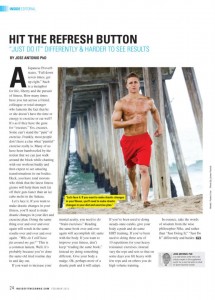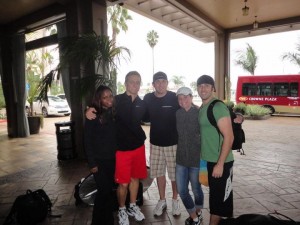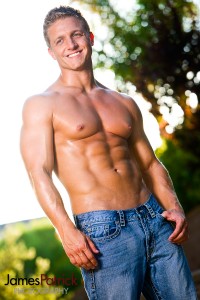For my second interview, I chose to talk to Parker Cote. I first had the opportunity to meet and work with Parker in Los Angeles at the 2010 FMI conference. We shot together again when FMI came out to Scottsdale. It was shortly after that when we worked together yet again in Las Vegas around Olympia. Our last project being again in Los Angeles at FMI which was published both in Inside Fitness Magazine and Max Sports & Fitness Magazine.
For those of you that know Parker, you know how relentless and passionate he is about what he does and what he wants to achieve. I’ve greatly admired his tireless drive and as such have chosen him to be the February 2012 Featured Talent. I hope you enjoy the interview!
James Patrick: What was your first push in the fitness modeling industry?
Parker Cote: I first started to pursue fitness modeling as a 20-year old college student. I had been exercising regularly and eating well since my freshman year of high school and I decided that I finally had the physique to go after my dream. I found my first opportunity on a Bodybuilding.com forum where I saw a thread that was looking for people to feature in a national ad campaign for the site. The best part was that they were looking for “real people” who used their site with success, not professional fitness models. I submitted some pictures my dad took of me in my home gym and a few months later I had a full-page ad in all the major fitness magazines. From there I booked my first workout spread and interview in a national fitness magazine.
JP: Understanding there are a lot of guys in great shape; how did you separate yourself from others?
PC: The fitness industry is fiercely competitive, but there are a few things that I’d like to think makes me unique. The first is that I have a story that people can relate to. A picture in a magazine of someone in great shape is good, but that same picture with a story of how they got there is infinitely more valuable. Having a story with experiences that others can relate to is a great way to establish your identity in the fitness industry.
For me, I began weight training when I was 15 years old and weighed only 145 lbs. I made consistent progress over the course of several years until I became a professional fitness model. I took pictures throughout the entire process, I even have a photo from the day I started. When people see that picture of me as a skinny high schooler it can inspire them to get in shape.
In addition to having a story, I know my market. I don’t feel pressure to gain a lot of size or vascularity to get into the hardcore bodybuilding magazines, or sign with a supplement company. I’m certainly not the most muscular guy in the industry, but I know my niche. I want to appeal to the mainstream-people who want to look normal in clothes but great when their shirt comes off. Knowing where I stand makes my efforts much more focused and purposeful.
Finally, I’m always professional. I show up to shoots in shape, on time, and ready to work. I also make sure that the photographer and I are having fun – it’s important to show your personality and make the shoot an enjoyable experience.
JP: Early in your career, what were some of your goals in the business?
PC: In the beginning I simply wanted to be published in national fitness magazines with the dream of one day appearing on a cover. I also wanted to share my transformation story to help motivate others. It has grown and evolved since to include other aspects of the industry with a larger focus on helping others achieve their goals.
JP: How did you go about selecting photographers to work with to build your portfolio?
PC: I did my research. Since my main goal was to be published, I wanted to shoot with the photographers who were being published. I looked to see who was shooting for the magazines that I thought I would be a good fit for, and then contacted them. I also made sure that they specialized in fitness. In the beginning, it is easy to get caught up in the excitement of being a model and shoot with anyone with a camera. It is important to take your time and select photographers who will advance your career. There is also something to be said about the photographer’s personality. If they are easy to work with and we get great images, I keep that in mind when I’m looking to refresh my portfolio.
JP: What lessons did you learn about successful tips for shooting and also things to avoid doing?
PC: The best piece of advice I can give to someone getting ready for a shoot is to avoid extremes. The first photographer I ever shot with taught me that. I was so excited about my first shoot I was thinking to myself, “I’m going to diet so hard for this and get as lean and shredded as possible.” I was reading up on supplements to take to cut water, and other tricks to get me super lean. Thankfully the photographer warned me against that, and I decided that I needed to get into shoot shape without supplements or any drastic measures so I could reproduce it whenever I needed to. There are some minor changes in diet and training that I will implement leading up to a shoot, but it is never anything that puts extreme stress on my body.
It is also important to come to your shoot with an even tan – either natural or from a tanning product. Make sure you get a full night’s sleep the night before your shoot so you look your best, and always bring some healthy food with you so you can keep your energy levels up throughout the day. It is also a good idea to bring some business cards or comp cards to the shoot for networking purposes. Someone on set may even know of another job you’d be good for, so make sure you come prepared.
Looking great is only half of the job. It is equally important to be professional and pleasant to work with on set. Show up on time, have a positive attitude, and enjoy yourself. While it can be a lot of fun, it’s still work and you are there to get a job done for a client. Make sure you don’t have any other plans the day of the shoot. I have had ten hour days on set when I was expecting a four hour shoot. It is never appropriate to ask when the shoot will be over, complain, or ask if you can leave. Avoid texting or calling people while you’re on a shoot, it is disrespectful. When the shoot is over, thank them for inviting you to work with them that day and leave on a positive note. If someone does a favor for you or you enjoyed working with them, send a hand written thank you. It’s old school manners that will get you remembered in a good way.
Special note- if you are hiring a photographer to shoot portfolio images, the same guidelines apply. However, if you post the images online, make sure you ask the photographer for permission and give them photo credit, they are trying to grow their business as well.
JP: You travel a lot and attend a lot of shows and conferences. Explain your reasoning behind this.
PC: The main benefit to attending shows and conferences is networking. Unlike fashion and commercial models, fitness models are their own best agents. Industry events provide you with the opportunity to meet and speak face to face with magazine editors, photographers, supplement companies, and other models. Submitting pictures through email is fine, but allowing the decision makers to meet you and get to know your personality is invaluable. Plus, they are a lot of fun to attend and it’s a great way to become friends with other fitness models.
Another benefit of industry events is that it is a great place to shoot. All of the industry’s best photographers and models are usually in attendance, so if you plan ahead you can get some great shoots in. At an expo I recently attended, I had the opportunity to shoot with a very well known female fitness model for cover submissions – a chance I wouldn’t get if I had flown myself out to shoot with the photographer. I usually schedule anywhere from 2-5 shoots per event I attend. It is an efficient way to get work done. Since I live in Boston I have to make the most out of every time I travel.
JP: You have recently been picked up but a multitude of publications. How have you gone about marketing yourself to various magazines?
PC: There are several different ways to be featured in a fitness magazine. You can book a shoot through an agent, a photographer can shoot and submit you, or you can directly submit yourself. I have found the most success submitting on my own. I have gotten a majority of my own work without an agent. What I do is find out who the decision makers are (editors, art directors, etc.) and present them with what I have to offer in a professional way. I’ll typically email them a couple of my best images, introduce myself and provide some background information, and tell them I am available to shoot whenever they need me. I also follow up consistently, but not so much that they become annoyed. It took me a full year of following up for me to book a shoot with Men’s Health – it all depends on how badly you want it.
JP: Now that your name is a bit more established, what are some of your goals moving forward?
PC: In the past year I have matured beyond a myopic view of myself as only a fitness model. I have expanded into commercial modeling and writing, and started my own website where I sell workout and nutrition plans. When I first started in the fitness industry, I never imagined I’d be shooting with Mark Wahlberg or appearing on a billboard for a clothing company. I also never thought I’d be writing for national magazines. That is the direction my career is headed and I couldn’t be happier. As far as future goals are concerned, I want to continue to be published regularly as a fitness model and writer, book more covers and commercial work, and increase presence on my social networks and website, ParkerCote.com.
James Patrick
www.jamesmpatrick.com






